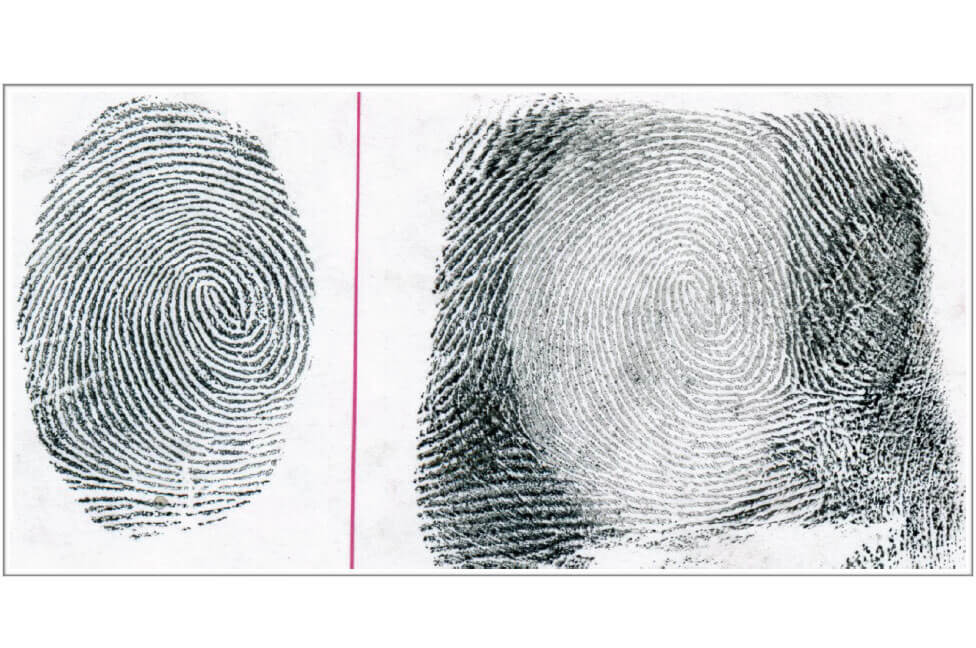Exposing the Enigma of Uniqueness: The Fascinating World of Fingerprint Identification
05/07/2024
by Kourosh Nikoui | May 7, 2024 | Fingerprints
In the vast tapestry of human existence, no two individuals are exactly alike. From our DNA to the intricacies of our fingerprints, nature gives each of us a unique identity. Join us as we explore the captivating realm of fingerprint identification, where the mystery of uniqueness unfolds before our eyes.
The Uniqueness of Fingerprints
At the heart of fingerprint identification lies the enigma of uniqueness. Unlike facial features or iris patterns, fingerprints possess an unparalleled level of individuality. But what exactly makes fingerprints unique?
Factors Contributing to Uniqueness
- Ridge Patterns: The surface of our fingertips is covered with ridges and valleys, forming intricate patterns as unique as our DNA. These ridge patterns are shaped by a mix of genetic and environmental factors, resulting in many unique
- Minutiae: Beyond the main ridge patterns, fingerprints have finer details called minutiae. These include ridge endings, bifurcations, enclosures, and other subtle features that add to the overall uniqueness of each fingerprint.
- Third-Level Details: Fingerprint identification also relies on analyzing third-level details such as scars, ridge length, ridge contour, pore placements, and pore shapes. These minute characteristics provide additional layers of complexity and individuality.
- Ridge Width (Ridge W): Ridge width, or ridge thickness, is another important factor. The width of ridges can vary significantly between individuals, adding another dimension of uniqueness to fingerprint patterns.
Factors Analyzed by Fingerprint Examiners
In forensic science, fingerprint experts employ a meticulous process to analyze and identify fingerprints, focusing on several key factors:
- Ridge Patterns: Forensic investigators examine the overall ridge patterns of latent fingerprints recovered from crime scenes, classifying them into three main types: arches, loops, and whorls. They also analyze subtypes and individual ridge characteristics to establish unique identifiers.
- Minutiae: Minutiae are the tiny details or characteristics found in the ridge patterns of fingerprints that are used for biometric identification. These details include specific points where ridges end (ridge endings), where ridges split into two (bifurcations), and other ridge features like dots and islands. Minutiae points are crucial because they provide a unique and reliable basis for fingerprint recognition systems. The process of identifying and associating minutiae patterns forms the basis of minutiae-based fingerprint recognition technology, which is widely used in forensic investigations and biometric authentication
- Third-Level Details: Fingerprint analysts analyze third-level details such as scars, ridge length, ridge contour, pore placements, pore shapes, and ridge width to further refine their analysis and enhance the accuracy of
- Position and Orientation: The position and orientation of ridge features within a fingerprint are carefully scrutinized to ensure accurate matching and identification. Even subtle variations in angle or alignment can provide valuable clues in forensic investigations.
The Enduring Legacy of Uniqueness
In a world defined by change and uncertainty, fingerprints stand as immutable testaments to the enduring legacy of uniqueness. From ancient civilizations to modern- day forensic laboratories, the timeless mystery of fingerprint identification continues to captivate our imagination and inspire awe. Through the meticulous art of analysis and comparison, fingerprint examiners unravel the secrets hidden within these intricate patterns, illuminating the path to truth and justice one fingerprint at a time.
Conclusion
In the intricate tapestry of human identity, fingerprints serve as silent witnesses to the timeless mystery of uniqueness. Through their intricate patterns, minutiae, third-level details, and ridge width, fingerprints embody the essence of individuality, offering a glimpse into the innermost depths of our identity. As forensic investigators unravel the secrets hidden within these timeless enigmas, they unlock the door to truth and justice, revealing the profound significance of uniqueness in the grand tapestry of human existence.
Sources:
- nlm.nih.gov – Forensic Comparison and Matching of Fingerprints
- net – Level 3 details and their role in fingerprint identification
- rutgers.edu – No Two Finger Prints Are Alike
- springer.com – Fingerprint, Forensic Evidence of
- cliffsnotes.com – Describe how and when fingerprint ridges form
Forensic Investigator and Specialist Kourosh Nikoui, Principal Consultant and CEO of Nikoui & Associates, Forensic Identification Services & Consulting, Inc., has over 38 years of full-time experience in forensic science and criminal justice with various law enforcement agencies, government and private entities. Mr. Nikoui, a court-qualified expert, is a Certified Latent Print Examiner, Certified Senior Crime Scene Analyst, and Certified Forensic Photographer by the International Association for Identification. He has testified as an expert witness over 150 times in California Superior and U.S. Federal Courts, processed evidence in over 30,000 criminal and civilian cases, and served as a consultant to numerous law enforcement agencies. Mr. Nikoui holds a BFA degree from USD and is an active member of multiple forensic science organizations. He can be reached directly by calling (866)439-6753 or by email at [email protected]
